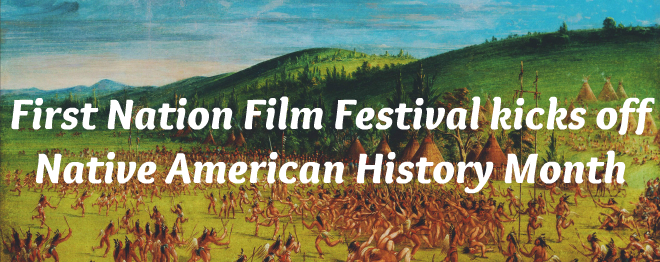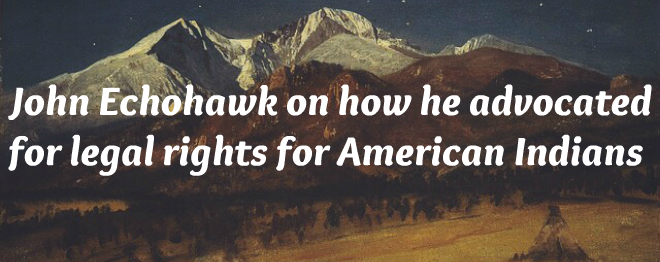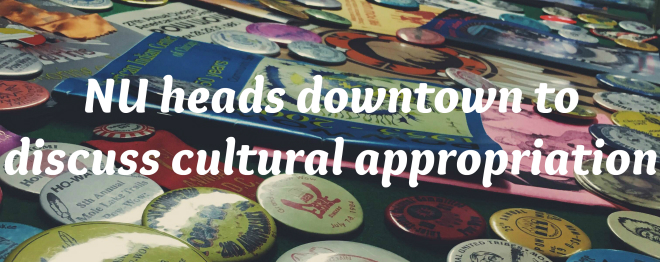Just over 150 years ago, Northwestern University founder and Gov. John Evans was the superintendent of Indian Affairs of the Colorado Territory, where American soldiers killed about 150 Native Americans, primarily women and children. Last year, Northwestern commissioned a report on Evans' role in the massacre, concluding that while he did not personally plan or condone the killings, he helped create a situation that made the massacre possible.
Evans' name is still on the University's alumni center, something that the Native American and Indigenous Student Alliance (NAISA) is fighting to change. The group released a petition on November 21 demanding that the name be removed from the alumni center as well as faculty positions. Some Northwestern faculty have also pushed for a Native American Studies department.
While the University has yet to make those large scale changes, they have made some efforts to increase visibility of Native American issues. In late October, the school began its search for new faculty members that work in the field of indigenous studies and administrators to deal with diversity in the context of Native Americans. Students also got new options for courses related to Native American history, and the members of the freshman class that actually opened their summer reading books read “The Inconvenient Indian” by Thomas King.
With November being Native American History Month, Northwestern also created a series of events designed to recognize the University's history with and subjugation of Native Americans, as well as look ahead to new initiatives to promote inclusion and outreach with the community.
Read on to learn more about Northwestern's programming for Native American History Month, and how they used the month to grapple with these issues and many more.

By Libby Berry
To kick off Native American Heritage Month, a small group of Northwestern students and faculty gathered in Harris Hall on Nov. 2 for a night of pizza, cider and a collection of films made by Native artists. The event, hosted by NAISA, was held in conjunction with First Nation Film and Video Festival Inc.
Ernest Whiteman III, the director of FNFVF, described the Chicago-based nonprofit as a group working to “support Native American filmmakers of all skill levels and give them a venue to show their work.” According to NAISA co-president and SESP senior Forrest Bruce, this is the second time FNFVF has connected with the Northwestern community.
“Ernest reached out to us winter of my sophomore year, two years ago, and we held a winter festival at Northwestern,” Bruce said. “We heard this summer he was having a fall festival and was interested in collaborating with us, so we figured it’d be good to add him to the program of Indigenous Heritage Month.”
If the applause that concluded the evening was any indication, Mr. Whiteman certainly didn’t disappoint, bringing six films to this season’s festival. Addressing topics such as Native language, leaders in the Indigenous community like George Manuel and the horrors of residential schools, those in attendance said the evening was a learning opportunity. Medill professor and One Book One Northwestern Chair Loren Ghiglione particularly appreciated a film called “Sayachapis,” which told the story of a man who recounts a childhood filled with abuse.
The major goal of the evening was to educate the Northwestern community about Native history and issues, and encourage students and faculty to increase the community's visibility, according to Ghiglione.
NAISA, a small but dedicated group, has been working to ensure these Native issues no longer go unnoticed.
“One of the biggest things we’ve done is getting the University to recognize John Evan’s role in the Sand Creek Massacre and we want to get the ball rolling on making this a better source of support for Native people, especially in the Chicago and Great Lakes area,” Bruce said. “We just try to advocate for Native people here when there’s so few of us."

By Gillian Grossen
As part of the 6th Annual Dr. Carlos Montezuma Honorary Lecture and Awards Ceremony, people from the Chicago area met at the Mitchell Museum of the American Indian to celebrate and honor the memory of Carlos Montezuma and the recipiants of this year’s awards.
The main speaker at the Nov. 10 event was John E. Echohawk, part of the Pawnee tribe, who paved the way for American Indians in the legal field. He was the first graduate of New Mexico’s special program for Native American lawyers and the founder of the Native American Rights Fund (NARF), and has served as its Executive Director since 1977.
Echohawk began by discussing his background. Although he was part of the Pawnee tribe, Echohawk was raised in New Mexico near the Navajo and Apache tribes, which would later influence his work as he fought for the rights of these groups. Echohawk earned a scholarship to the University of New Mexico, which had very recently begun a program to try to increase the representation of Native Americans in the law field.
During his time in law school, he attended one of the first courses ever taught on federal American Indian law, policy and treaties.
“All of these other Indian students and I started to see that we didn’t know any of this, we had never been taught this, the tribal leaders don’t know this, but we had a lot of rights," Echohawk said. "It turns out, in this country you may have a lot of rights, but if you don’t have a lawyer to assert those rights, you may as well not have any.”
This revelation lead Echohawk to found NARF, a nonprofit dedicated to providing Native Americans with lawyers to help right injustices against tribes across the nation. Most work is done on the West Coast and in Alaska, where most of today’s tribes reside.
Echohawk described some of the landmark cases that kick-started NARF. One of the very first regarded tribes near Puget Sound in the Northwest, where tribes who had been dependent on fishing for thousands of years were being forced to get fishing licenses against treaty rules.
They won the initial case, but fisherman across the state of Washington began to protest. The case went on to the Supreme Court, where Echohawk and NARF succeeded. Later on, NARF filed a federal law suit for two-thirds of the state of Maine, in protest of land illegally taken from tribes. This case too went on the Supreme Court, where NARF agreed to a large land and monetary settlement.
Its no wonder that Echohawk was recognized as one of the 100 most influential lawyers in America by the National Law Journal; he truly paved a path and changed history for Native Americans across the nation – and is continuing to do so.

By Abby Blachman
NU in Chicago hosted a trip to the American Indian Center of Chicago on Nov. 15 giving students the chance to explore the culture and history of Native Americans in the area. The event also focused on cultural appropriation and its many modern manifestations with regard to Native populations. Students were given a tour of a garden that is used to educate students about both science and Native American culture, listened to a talk about cultural misconceptions of Natives given by the Center’s director Andrew Johnson and tasted traditional Native American dishes. They then returned to campus where the Chi Nation’s Youth Council presented on cultural appropriation.
A recent topic of conversation and debate at the Center has been the nature of the logo and name of Chicago’s National Hockey League team, the Chicago Blackhawks. The team’s current logo is a native man wearing three feathers in his hair. At Blackhawks games, fans often sport feather headdresses and other feathered clothing items, according to Johnson.
“Our people didn’t wear feathers or headdresses,” said Cindy Fox-Star, the traditional Native cook who works at the Center. Fox-Star explained that recently, the Blackhawks agreed to meet with the A.I.C., and representatives from the Center informed them of the ways in which they were misrepresenting the Blackhawks. Fox-Star said that the Center wants to continue working with the Blackhawks to portray Natives positively and accurately, and that it plans to coordinate a traditional dance to be performed at a game.
Upon returning to campus, the group heard a presentation from Chi Nations Youth Council, whose mission is to create a supportive and open environment for Native youth. Anthony Pochel Tamez, a high school student and co-president of the Chi Nations Youth Council, presented a different problematic aspect on the Blackhawks’ use of native symbolism.
“When we talk about these logos, they make us not human. People do this to make racism okay. When they say the Blackhawks aren’t racist, they’re making it okay, and they’re making themselves feel comfortable,” said Pochel Tamez.
Pochel Tamez explained that because of the Council’s differing perspective on the Chicago Blackhawks and their role in cultural appropriation, they had to cut ties with the American Indian Center. The Council’s co-president also spoke of other common forms of cultural appropriation that he and his peers deem unacceptable, including the widespread use of Native patterns in modern fashion.
Medill junior Lorenzo Gudino, the treasurer of NAISA and a member of the Fort Sill Apache Tribe, said that he was glad that Northwestern students had the chance to understand how complex issues like the Blackhawks’ inaccurate portrayals of Native populations and the fashion industry’s use of tribal patterns affect Native American students every day.
“A lot of people just don’t know that they are culturally appropriating and that it does put a toll on different Native American students on campus and Native Americans in general. It’s just all about the education and learning. It does bother us, and there is a need to think more critically about this,” Gudino said.

By Rachel Frazin
One Book One Northwestern hosted Dittmar Dinner on Nov. 17 where Psychology Prof. Doug Medin, who has created programs at the American Indian Center of Chicago, spoke on the tangible, harmful effects of stereotypes for Native American communities.
“First Nations people’s suicide rates in British Columbia [are] three times as high as the overall average,” he said.
Medin said these issues hit home here in Chicago, and projected an image of the Chicago Blackhawks mascot to illustrate his point.
Medin also delved into the different perspectives on nature held by Native Americans and non-Natives: they consider themselves to be a part of nature, while non-Natives tend to view themselves as distinct from nature. He showed the participants of the dinner several pictures with various degrees of nature and buildings and asked them to raise their hands if they considered it to be an ecosystem.
After he spoke, each table of about eight people participated in a student-led discussion on their opinions on questions having to do with Professor Medin’s lecture. As the professor circled the room, the tables pondered questions about humanity's role in nature, whether Northwestern's campus was an ecosystem and whether mascots like the Blackhawks' can be condoned.
It was the last question that drew the strongest reaction: many agreed that “Redskins” in particular is a derogatory term, and that cultural appropriation at sporting events is problematic. However, they questioned the feasibility of changing these names.
This is the sixth year of Dittmar Dinners, which happen twice every year. They started when Nancy Cunniff became the coordinator of the One Book One Northwestern program with Rebecca Skloot’s book, Henrietta Lacks because, according to Cunniff, it has a lot of social and scientific issues that Northwestern professors had expertise in.
She said that although the Dittmar Dinner differs from year to year, they usually go very well. The next one will take place in January. About thirty people, including Northwestern students and faculty attended the event.
“It’s just a nice way to have a discussion,” Cunniff said. “It’s almost like around the family dinner table.”

By Tracy Yu
Navajo multimedia creator Pamela J. Peters gave a presentation on her project “The Legacy of Exiled NDNz” on Nov. 19 in Annie May Swift Hall. Born and raised on the Navajo reservation, Peters is now based in L.A. and committed to telling the unfiltered stories of the modern American Indian.
Peters said her visit with Native American Heritage Month matched well with the encroaching uproar of Thanksgiving, a holiday that she said smears “myth” over “real history.” Upon taking the stage, Peters quickly set the record – hundreds of years old and murky with various and continuous mistreatment – straight. Her project tackles these persisting ailments head-on.
What began as a short film inspired by the 1961 neorealist project Exiles currently unfolds as a full-length documentary following the lives of seven indigenous young persons. She said her project aims to “commemorate the legacy of the relocation program” that resulted from the Indian Relocation Act of 1956. Peters is keen to reverse static stereotypes of historical and contemporary indigenous life, which is comprised of “many nations with many stories,” she said.
Peters said that the vast culture of American Indians has been butchered and bandied under static associations like “braids, beads and buckskin.” With over 567 federally recognized tribes and more than 150 active native languages, it seems incongruent to her that indigenous people be shoved under one common, single-dimensional umbrella.
Yet Peters said that even that narrow depiction is problematic, with traditional western media repackaging the American Indian alongside terror and violence. She said the “savage,” a roadblock to Manifest Destiny, is smacked next to the heroic, progressive cowboy.
Overall, Peters said Western media has only churned out “the most readily available clichés, the de-facto truth of identity.” She believes these whitewashed revisions of history and modern life spread false and degrading assumptions that take root in public consciousness.
Beyond traditional media, Peters also called out American cultural norms. She was concerned with the commodification of native culture with Thanksgiving, Columbus and Halloween – none of which exist in innocuous vacuums of fun and games; rather, they push xenophobia and intolerance further to the forefront of American political dialogue.
“When it’s okay to play cowboys and Indians as children, it’s okay to play cowboys and Indians as adults for frat parties," Peters said.
Peters wants to halt and heal such damage. Her projects are made with the intention to move public awareness forward and to rehabilitate mistaken thinking through the real narratives of real indigenous people. “Legacy of Exiled NDNz” features participants from several different tribes (Seminole, Choctaw, Cherokee, Barona Band of Mission Indians, etc.), none of whom knew each other prior, excepting one (now married) couple.

By Elise Echeverria
NAISA held a an event commemorating the 151st Anniversary of the Sand Creek Massacre on Nov. 21 following the Dittmar Memorial Gallery at Norris.
“Last year was the 150th anniversary, which is a really nice number, but we didn’t just want to make it a one-time thing,” said NAISA co-president Forrest Bruce. “We want it to be engrained as a tradition in the institution.”
Bruce said NAISA is making an effort to make the Commemoration of the Sand Creek Massacre their signature annual event, which was sponsored by Multicultural Student Affairs and One Book One Northwestern. This year’s commemoration featured a prayer from Father Peter Powel of St. Augstine’s Center for American Indians, various speakers, and opening and closing songs from Red Line Drum.
Dr. Leslie-Ann Brown Henderson, Executive Director of Campus Inclusion and Community, spoke at the event, where she announced the addition of of an associate director of student multi-cultural affairs to help with outreach for Native Americans.
“History matters,” Henderson said. “We are going to be committed to increasing the visibility of Native students.”
In addition to commemorating the Sand Creek Massacre, NAISA students also brought up their petition and desire to rename the Northwestern Alumni Building at 1800 Sheridan Road. The alumni building is currently named after John Evans, the namesake for Evanston, and someone who played a role in the Sand Creek Massacre.
That morning, NAISA students raised a white flag below the American flag in front of the Evans Alumni Center, in a tribute to the flags Black Kettle – a leading Cheyenne chief – flew above his lodge before the Sand Creek Massacre occurred.
NAISA treasurer Lorenzo Gudino said they hoped raising the flag would start a discussion.
“I think that in honoring Evans by placing his name on buildings, the University kind of shows its racist values in that it is prioritizing the name of a wealthy white man over hundreds of indigenous lives,” Bruce said. “In order to create a space that is accommodating to everyone that it is really important to change the name.”
NAISA had their petition available for attendees to sign on the way out where they additionally received homemade tobacco ties.
Bruce said that while they don’t have a specific number of signatures they are hoping to get, once they have something tangible that demonstrates that a significant amount of people are behind them, they hope to bring it to the University’s attention and that President Schapiro will see it.
Editor's note: A previous version of this story incorrectly identified Pamela J. Peters as Pamela J. Sanders. Thank you to Ms. Peters for noting this error.